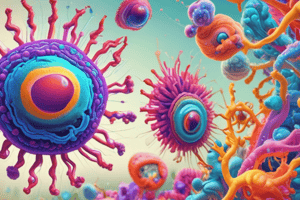Podcast
Questions and Answers
What is the basic structural and functional unit of all living organisms?
What is the basic structural and functional unit of all living organisms?
- Molecules
- Atoms
- Cells (correct)
- Tissues
Which type of cells lack a nucleus and membrane-bound organelles?
Which type of cells lack a nucleus and membrane-bound organelles?
- Muscle cells
- Prokaryotic cells (correct)
- Epithelial cells
- Eukaryotic cells
What is the main function of the digestive system?
What is the main function of the digestive system?
- Reproduction
- Response to stimuli
- Exchange of oxygen and carbon dioxide
- Obtaining nutrients from food (correct)
Which type of cells possess membrane-bound organelles like the nucleus and mitochondria?
Which type of cells possess membrane-bound organelles like the nucleus and mitochondria?
What is responsible for the exchange of oxygen and carbon dioxide between the body and the environment?
What is responsible for the exchange of oxygen and carbon dioxide between the body and the environment?
Which type of tissues do organs like the liver, lungs, and kidneys consist of?
Which type of tissues do organs like the liver, lungs, and kidneys consist of?
What is the main focus of genetics?
What is the main focus of genetics?
What encodes for specific proteins within living organisms?
What encodes for specific proteins within living organisms?
Which process is responsible for the emergence of new species over time?
Which process is responsible for the emergence of new species over time?
What study deals with the distribution and abundance of species?
What study deals with the distribution and abundance of species?
What theory states that organisms with advantageous traits are more likely to survive and reproduce?
What theory states that organisms with advantageous traits are more likely to survive and reproduce?
Which evidence supports the concept of evolution?
Which evidence supports the concept of evolution?
Flashcards are hidden until you start studying
Study Notes
Biology: Uncovering Life's Wonders
Biology is a vast and fascinating field that explores the natural world, from the tiniest microorganisms to the grand complexity of ecosystems. Let's delve into some of the foundational aspects of this science, uncovering the wonders it reveals.
The Building Blocks of Life: Cells
At the heart of biology lies the cell, the basic structural and functional unit of all living organisms. Cells come in two main types: prokaryotic and eukaryotic. Prokaryotes, such as bacteria, lack a nucleus and membrane-bound organelles, while eukaryotes, like us humans, possess membrane-bound organelles, such as the nucleus, mitochondria, and endoplasmic reticulum.
Cells have specific functions, such as metabolism, growth, response to stimuli, and reproduction. They work together to create complex organisms through cell division, communication, and specialization.
Structural Organization: Tissues, Organs, and Systems
Organisms consist of many types of cells organized in tissues, such as epithelial, muscle, and connective tissues. Tissues form organs, like the liver, lungs, and kidneys, which work together in systems, such as the digestive, respiratory, and excretory systems.
For example, the digestive system is responsible for breaking down food and obtaining nutrients, which are then distributed throughout the body. The respiratory system facilitates the exchange of oxygen and carbon dioxide between the body and the environment.
Genetics: The Language of Life
Genetics is the study of heredity and variation in living organisms, focusing on the DNA molecule, which contains genetic information. DNA is organized into segments called genes, which encode for specific proteins. Proteins are essential for the structure and function of cells and organisms.
The DNA molecule carries genetic instructions that inform the development, growth, and behavior of living organisms. Genetic variation, or differences between individuals, can be attributed to mutations, recombination during reproduction, or gene flow.
Ecology: The Interaction of Organisms and their Environment
Ecology is the study of interactions among organisms and their environment, exploring how various species interact with each other and their physical surroundings. Biogeochemical cycles, such as the water and carbon cycles, are crucial to understanding how organisms and their environments interact.
Population ecology deals with the distribution and abundance of species and the factors that influence these factors. Communities consist of populations of different species living in the same area, and ecosystems are comprised of communities and their physical environment.
Evolution: The Story of Life's Diversity
Evolution is the change in the genetic composition of a population over time, resulting in the emergence of new species. Darwin's theory of natural selection states that organisms with advantageous traits are more likely to survive and reproduce, passing these traits on to their offspring. Over generations, these advantageous traits are more prevalent in the population, leading to the emergence of new species.
Evidence of evolution includes the fossil record, comparative anatomy, and molecular biology. The study of evolution provides an explanation for the impressive diversity of life on Earth.
In conclusion, biology is a thrilling and multifaceted field that allows us to appreciate the intricate and interconnected workings of life. Through its various subdisciplines, we continue to uncover the mysteries of the natural world, elucidating the complexities of life and our place within it. Dawkins, R. (2006). The Ancestor's Tale: A Pilgrimage to the Dawn of Evolution. Houghton Mifflin Harcourt. Earnshaw, J. C., et al. (2002). Biology: The Dynamics of Life. 5th ed. McGraw-Hill. Enders, G., et al. (2009). Biology: Exploring Life. 3rd ed. Cengage Learning. Freeman, S., et al. (2013). Biology. 9th ed. W. W. Norton & Company. Hodges, R. R., et al. (2005). Biology: A Self-Discovery Approach. 5th ed. W. W. Norton & Company. Orgel, L. E., & Crick, F. H. C. (1980). Central Dogma of Molecular Biology. Nature, 287(5790), 315–319. Watson, J. D., & Crick, F. H. C. (1953). Molecular structure of nucleic acids: a structure for deoxyribose nucleic acid. Nature, 171(4356), 737–738.
Studying That Suits You
Use AI to generate personalized quizzes and flashcards to suit your learning preferences.




